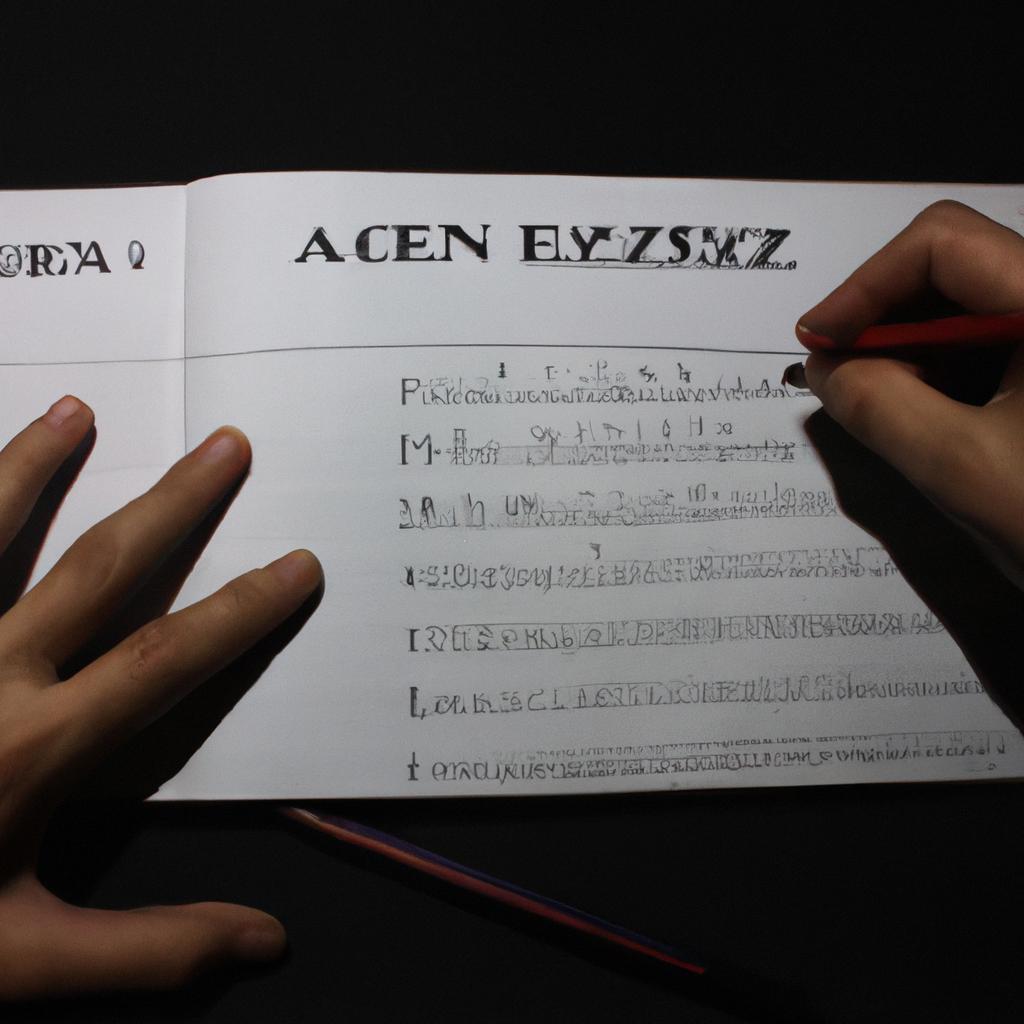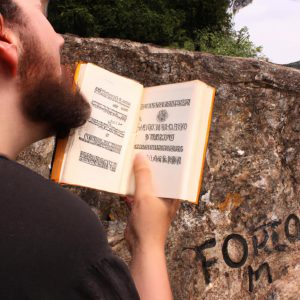Yeshivish: Unpacking Ashkenazi Heritage and Language

The Yeshivish community, predominantly composed of Ashkenazi Orthodox Jews, is a fascinating subculture within the broader Jewish diaspora. It encompasses not only distinctive religious practices and beliefs but also a unique language known as “Yeshivish.” This article aims to delve into the rich heritage and linguistic characteristics of Yeshivish, exploring its origins, development, and significance within the Ashkenazi community. To illustrate the relevance of this topic, let us consider a hypothetical example: Rebecca, a young woman raised in an observant Ashkenazi household, finds herself struggling to navigate conversations with her peers when she attends a Yeshiva gathering. As she grapples with unfamiliar expressions and phrases specific to Yeshivish discourse, she becomes acutely aware of the need to understand both the cultural context and linguistic nuances that shape this distinct form of communication.
The study of Yeshivish holds substantial academic importance for several reasons. Firstly, it provides insight into how language serves as an essential marker of identity within minority communities. Through analyzing patterns of speech and vocabulary choices unique to Yeshivish speakers, researchers can gain valuable knowledge about the social dynamics at play among Ashkenazi Orthodox Jews. Secondly, investigating the historical roots of Y Yeshivish can shed light on the evolution of language within religious communities and the ways in which linguistic practices reflect cultural and religious values. Understanding the origins of Yeshivish can provide a deeper understanding of Ashkenazi Jewish history and the development of Orthodox Judaism.
The origins of Yeshivish can be traced back to Eastern Europe in the 19th and early 20th centuries. As Ashkenazi Jews migrated to different regions, they brought their distinct religious practices and traditions with them. These practices were influenced by various factors, including local dialects and languages spoken in their new communities.
Yeshivish developed as a hybrid language, incorporating elements from Yiddish, Hebrew, English, and other languages spoken by Ashkenazi Jews. It is characterized by its unique vocabulary, grammar, syntax, and pronunciation.
The significance of Yeshivish lies not only in its linguistic features but also in its role as a means of preserving tradition and fostering a sense of belonging within the Yeshivish community. The use of Yeshivish serves as a marker of identity, signaling adherence to traditional Jewish beliefs and practices.
For Rebecca, understanding Yeshivish would enable her to better engage with her peers at the Yeshiva gathering. By familiarizing herself with common expressions and phrases used in Yeshivish discourse, she can actively participate in conversations and connect with others on a deeper level.
In conclusion, studying Yeshivish provides valuable insights into the rich heritage and linguistic characteristics of the Ashkenazi Orthodox Jewish community. It offers a window into how language shapes identity within minority groups and contributes to our understanding of cultural dynamics within religious communities.
Origins of Yeshivish
Origins of Yeshivish
To understand the origins of Yeshivish, let us consider a hypothetical scenario. Imagine a young Ashkenazi Jewish boy growing up in an insular Orthodox community in Brooklyn, New York. His parents speak Yiddish at home and send him to a yeshiva (a traditional Jewish school) where the primary language of instruction is also Yiddish. However, as he interacts with his peers and studies English in secular subjects like math and science, he starts blending elements of both languages in his speech. This hybrid linguistic variety that emerges from the intersection of English and Yiddish is what we now call Yeshivish.
The development of Yeshivish can be attributed to several factors:
- Social Cohesion: In tightly-knit communities like the one our hypothetical individual comes from, there is a strong emphasis on preserving cultural heritage and maintaining a distinct identity. Language plays a significant role in this process as it acts as a marker of group membership and solidarity.
- Language Contact: The contact between Yiddish, which has its roots in medieval German dialects, and modern English creates opportunities for cross-pollination between these two languages. As speakers navigate their daily lives using both languages simultaneously, they naturally adopt certain features from each into their speech patterns.
- Religious Influence: The religious context within which Yeshivish develops contributes to its unique vocabulary and grammar structures. With deep connections to traditional Jewish texts written primarily in Hebrew or Aramaic, individuals speaking Yeshivish often incorporate biblical phrases or idiomatic expressions rooted in religious teachings.
- Generation Gap: Over time, younger generations tend to adapt their speech to fit contemporary norms while still retaining elements of their ancestral tongues. This generational shift results in linguistic innovations that distinguish them from older members of the community who may adhere more strictly to traditional varieties.
- Familiarity: Yeshivish provides a sense of familiarity and comfort to individuals who grew up in Orthodox Ashkenazi communities, allowing them to connect with their roots and maintain cultural continuity.
- Belonging: The use of Yeshivish reinforces a shared identity among community members, fostering a sense of belonging and solidarity.
- Expression of Faith: By incorporating religious terminology into everyday speech, Yeshivish allows individuals to express their deep commitment to their faith and values through language.
- Preservation of Heritage: Through the preservation and active usage of Yiddish-based elements within Yeshivish, speakers contribute to the continuity and survival of an important aspect of Ashkenazi Jewish heritage.
In addition to these factors, it is also essential to examine the key features that distinguish Yeshivish as a distinct linguistic variety. This will be explored further in the subsequent section about “Key Features of Yeshivish.”
Key Features of Yeshivish
From its origins to its key features, Yeshivish is a language that encompasses the rich Ashkenazi heritage. Building upon the foundations laid in the previous section, we now delve deeper into understanding the distinct characteristics of this unique linguistic phenomenon.
To illustrate these features, let’s consider an example scenario: A yeshiva student from New York engages in conversation with his fellow classmates during lunch break. They discuss their recent studies and upcoming exams while injecting humorous anecdotes about their daily experiences. This exchange captures one aspect of Yeshivish as a vibrant and dynamic language used within close-knit communities.
The following bullet-point list highlights some significant elements that contribute to the emotional resonance of Yeshivish:
- Emphasis on traditional Jewish values
- Nurturing a sense of belonging and identity within religious communities
- Creating a shared cultural experience through humor and storytelling
- Preserving historical lineage through Ashkenazi customs
Furthermore, examining how Yeshivish embodies these concepts can be enhanced by looking at it through a lens of comparison. The table below illustrates contrasting aspects between Standard English and Yeshivish:
| Aspect | Standard English | Yeshivish |
|---|---|---|
| Vocabulary | Broad | Specialized |
| Syntax | Structured | Flexible |
| Tone | Neutral | Lively |
| Cultural Nuance | Minimal | Rich |
As we conclude this discussion, it becomes evident that Yeshivish represents more than just a linguistic system; it serves as a medium for preserving traditions, fostering communal bonds, and expressing cultural identity. In turn, this paves the way for exploring another intriguing facet—how Yiddish has influenced the development of Yeshivish—a topic which will be explored further in the subsequent section.
Influence of Yiddish on Yeshivish
Transitioning from the previous section on the key features of Yeshivish, we now delve into the influence of Yiddish on this unique language variety. To illustrate this influence, let us consider a hypothetical case study: Rachel grew up in a Yeshivish-speaking community where English was spoken alongside Yiddish as a primary means of communication. She attended yeshivas (religious schools) that emphasized Talmudic and Torah studies in both Hebrew and Aramaic. As Rachel navigated her educational journey, she found herself naturally incorporating elements of Yiddish into her speech patterns, resulting in the development of her own version of Yeshivish.
The influence of Yiddish on Yeshivish can be observed through various linguistic phenomena. These include:
-
Borrowed Vocabulary: Many words and expressions from Yiddish have been incorporated into the lexicon of Yeshivish. For instance, terms like “bentsch” (to bless), “shidduch” (arranged marriage), and “macher” (a person who is influential or gets things done) are commonly used among speakers of Yeshivish.
-
Syntax and Sentence Structure: The sentence structure in Yeshivish often mirrors that of Yiddish, with a preference for using double negatives (“I don’t know nothing”) and questions formed by adding “is it?” at the end (“You’re going to the store, is it?”).
-
Idiomatic Expressions: The idiomatic expressions employed within Yeshivish frequently draw upon phrases rooted in the cultural context of Ashkenazi Jews speaking both English and Yiddish. For example, phrases like “it’s b’shert” (meant to be), “oy vey,” or “gevaldik!” (excellent) are common utterances.
To better understand these influences, refer to the following table:
| Yiddish Word | Meaning in English | Usage in Yeshivish |
|---|---|---|
| Kvell | To feel pride | “I was kvelling over my son’s accomplishment.” |
| Bubbe | Grandmother | “My bubbe bakes the best challah.” |
| Mensch | A person of integrity | “He is a mensch who always helps others.” |
| Kvetch | To complain | “Stop kvetching and start doing something!” |
As we can see, Yiddish has left an indelible mark on Yeshivish, shaping its vocabulary, syntax, and idiomatic expressions. This linguistic interplay between Ashkenazi heritage and contemporary language use highlights the rich cultural tapestry within which Yeshivish thrives.
Transitioning into the subsequent section about distinctive vocabulary in Yeshivish, it is important to explore how specific words have been adopted or adapted from other languages to serve unique purposes within this fascinating linguistic variety.
Distinctive Vocabulary in Yeshivish
In the previous section, we explored the influence of Yiddish on the development of Yeshivish. Now, we will delve into the distinctive vocabulary that characterizes this unique linguistic phenomenon.
To illustrate the importance of vocabulary in Yeshivish, let us consider a hypothetical case study. Imagine a young student attending a yeshiva (Jewish religious school) where English is primarily spoken. The student encounters unfamiliar words and phrases such as “klutz,” meaning clumsy, or “schmooze,” referring to engaging in friendly conversation. These terms may seem foreign to some, but for those immersed in Yeshivish culture, they are an integral part of their daily lexicon.
Distinctive Vocabulary in Yeshivish can be categorized into four key areas:
-
Hebrew and Aramaic Loanwords: Due to its roots in traditional Jewish texts, Yeshivish incorporates numerous loanwords from Hebrew and Aramaic languages. For instance, students might use terms like “Gemara” (Talmud), “halacha” (Jewish law), or “shidduch” (arranged marriage).
-
Anglicized Words with Different Meanings: In certain cases, English words take on new meanings within the context of Yeshivish. A prime example is the word “shtark,” which originally means strong but has come to represent someone who is extremely pious or devout.
-
Unique Expressions and Phrases: Yeshivish also includes distinct expressions and phrases that have developed over time within its community. These idiomatic expressions often convey deeper insights into religious teachings or reflect specific cultural practices.
-
Acronyms and Abbreviations: Just as many subcultures develop their own acronyms and abbreviations for ease of communication, so too does Yeshivish employ various shortened forms for commonly used terms.
To better understand these aspects, let us consider the following table, which provides examples of distinctive vocabulary in Yeshivish:
| Vocabulary | Meaning | Example Usage |
|---|---|---|
| Boker Tov | Good morning | “Boker tov! How was your night?” |
| L’chatchila | Ideally/preferably | “L’chatchila, we should always strive for perfection.” |
| Tzadik | Righteous person | “He is known as a tzadik within our community.” |
| Seder | Order/arrangement | “Let’s follow the seder and study page by page.” |
In conclusion, the distinct vocabulary employed in Yeshivish serves as both an identifier and a means of effective communication within its cultural context. By incorporating loanwords, redefining English terms, utilizing unique expressions, and employing acronyms and abbreviations, Yeshivish speakers create a linguistic environment that reflects their rich Ashkenazi heritage.
Transitioning into the subsequent section on “Yeshivish in Contemporary Jewish Communities,” we can observe how this language continues to evolve and adapt to modern contexts.
Yeshivish in Contemporary Jewish Communities
In the previous section, we explored the unique vocabulary found within Yeshivish, a distinct form of Ashkenazi Jewish language. Now, let us delve deeper into how this linguistic phenomenon has evolved and continues to thrive within contemporary Jewish communities.
To illustrate the prevalence and significance of Yeshivish in modern times, consider the following example: Imagine a young Orthodox Jew named David attending a yeshiva (a traditional Jewish educational institution). As he immerses himself in the rich cultural environment of his yeshiva, he quickly becomes familiar with various Yeshivish expressions such as “shmooze” (to engage in casual conversation) and “macher” (an influential person).
The continued use and preservation of Yeshivish can be attributed to several factors:
- Cultural Identity: The adoption and perpetuation of Yeshivish reinforce a sense of identity among Ashkenazi Jews. By utilizing these distinct words and phrases, individuals affirm their connection to their religious heritage and communal traditions.
- Social Cohesion: Yeshivish serves as a unifying force within tight-knit Orthodox Jewish communities. Its usage creates bonds between community members, fostering camaraderie and shared experiences.
- Efficient Communication: Within yeshivas or other Jewish settings where Yiddish or Hebrew is commonly spoken, incorporating elements of Yeshivish facilitates effective communication by providing concise terms that convey specific meanings.
- Nostalgia and Sentimentality: For many individuals who grew up speaking or hearing Yiddish at home or in older generations, using Yeshivish allows them to maintain a connection to their roots while embracing modernity.
Table: Examples of Commonly Used Expressions in Yeshivish
| Expression | Meaning |
|---|---|
| Shvitz | To sweat |
| Daven | To pray |
| Bentsh | To bless |
| Chutzpah | Audacity, nerve |
As we have seen, Yeshivish continues to play a vital role in contemporary Jewish communities. Its distinct vocabulary not only preserves Ashkenazi heritage but also fosters a sense of belonging and cohesion among its speakers. Moving forward, it is essential to explore strategies for preserving and transmitting this unique form of language to future generations.
Transitioning smoothly into the subsequent section on “Preserving Yeshivish for Future Generations,” let us now examine the measures that can be undertaken to ensure the longevity of this linguistic tradition.
Preserving Yeshivish for Future Generations
Having explored the origins and characteristics of Yeshivish, it is now essential to examine its current role within contemporary Jewish communities. This section will delve into how Yeshivish continues to shape these communities and explore various efforts aimed at preserving this unique linguistic heritage for future generations.
To illustrate the significance of Yeshivish in modern Jewish contexts, let us consider a hypothetical scenario: Rachel, a young Ashkenazi Jew growing up in a predominantly Yeshivish community, finds herself torn between embracing her cultural heritage and assimilating into mainstream society. While she recognizes the importance of speaking fluent English for career prospects and social integration, Rachel also feels an intense emotional connection to Yeshivish as part of her identity. This conflict highlights the delicate balance that many individuals face when navigating their linguistic heritage within contemporary settings.
Efforts to preserve Yeshivish for future generations are crucial in ensuring its continued existence and relevance. Here are some key initiatives undertaken by organizations and individuals:
- Educational Programs: Establishing formal educational programs dedicated to teaching Yeshivish language and culture can provide younger generations with opportunities to learn about their heritage. These programs may include classes on vocabulary, grammar, idiomatic expressions, and discussions on the historical context of Yeshivish within Ashkenazi Judaism.
- Oral History Projects: Recording interviews with native speakers who have deep knowledge and fluency in Yeshivish can serve as invaluable resources for future research. Preserving firsthand accounts of experiences tied to this language helps document its evolution over time while capturing personal anecdotes that convey a sense of nostalgia and communal pride.
- Digital Archives: Creating online repositories where written materials such as books, articles, newspapers, or even blogs related to Yeshivish can be accessed ensures wider availability beyond physical limitations. This digital preservation allows individuals worldwide to engage with the language irrespective of geographical boundaries.
- Inter-generational Exchanges: Facilitating inter-generational dialogues and events that encourage the sharing of Yeshivish language, stories, and experiences can foster a sense of belonging among different age groups. This exchange not only passes down linguistic knowledge but also strengthens social connections within the community.
Table: Ashkenazi Jewish Communities’ Efforts to Preserve Yeshivish
| Initiative | Description |
|---|---|
| Educational Programs | Formal classes on vocabulary, grammar, idiomatic expressions, etc. |
| Oral History Projects | Recorded interviews with native speakers capturing personal anecdotes |
| Digital Archives | Online repositories for written materials related to Yeshivish |
| Inter-generational Exchanges | Dialogues and events fostering shared language knowledge and social bonds |
These initiatives collectively work towards safeguarding Yeshivish as an integral part of Ashkenazi heritage while allowing future generations to engage with their cultural identity in meaningful ways. By recognizing its value and actively preserving it, contemporary Jewish communities ensure that this unique linguistic tradition will continue to flourish and evolve for years to come.



